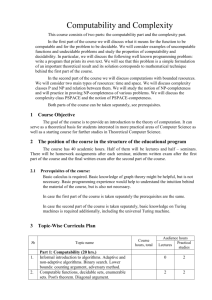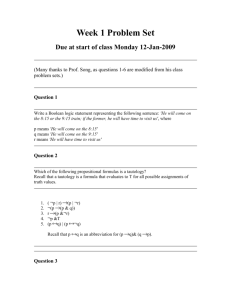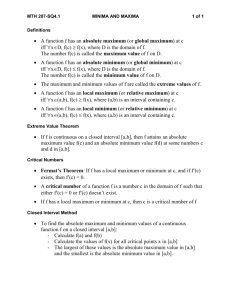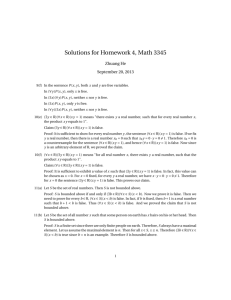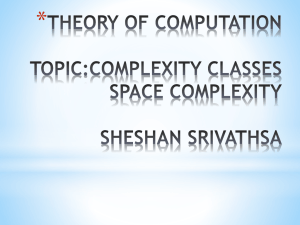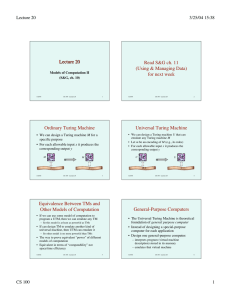91.502 Foundations of Computer Science 1 Final Exam This exam
advertisement
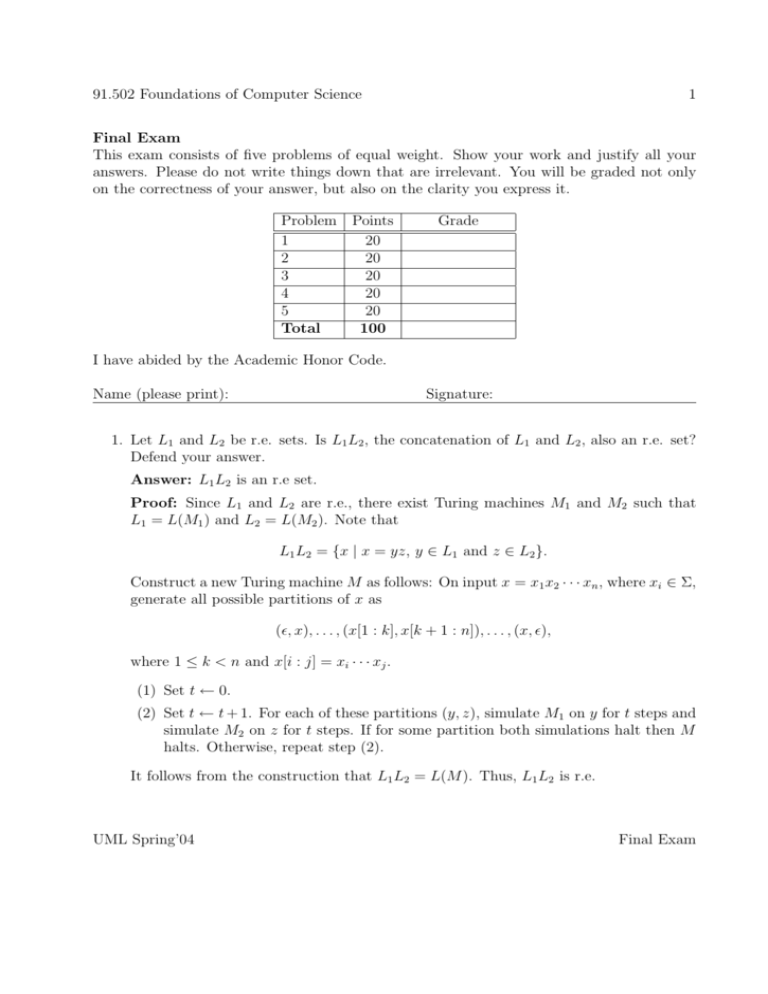
91.502 Foundations of Computer Science
1
Final Exam
This exam consists of five problems of equal weight. Show your work and justify all your
answers. Please do not write things down that are irrelevant. You will be graded not only
on the correctness of your answer, but also on the clarity you express it.
Problem Points
1
20
2
20
3
20
4
20
5
20
Total
100
Grade
I have abided by the Academic Honor Code.
Name (please print):
Signature:
1. Let L1 and L2 be r.e. sets. Is L1 L2 , the concatenation of L1 and L2 , also an r.e. set?
Defend your answer.
Answer: L1 L2 is an r.e set.
Proof: Since L1 and L2 are r.e., there exist Turing machines M1 and M2 such that
L1 = L(M1 ) and L2 = L(M2 ). Note that
L1 L2 = {x | x = yz, y ∈ L1 and z ∈ L2 }.
Construct a new Turing machine M as follows: On input x = x1 x2 · · · xn , where xi ∈ Σ,
generate all possible partitions of x as
(², x), . . . , (x[1 : k], x[k + 1 : n]), . . . , (x, ²),
where 1 ≤ k < n and x[i : j] = xi · · · xj .
(1) Set t ← 0.
(2) Set t ← t + 1. For each of these partitions (y, z), simulate M1 on y for t steps and
simulate M2 on z for t steps. If for some partition both simulations halt then M
halts. Otherwise, repeat step (2).
It follows from the construction that L1 L2 = L(M ). Thus, L1 L2 is r.e.
UML Spring’04
Final Exam
91.502 Foundations of Computer Science
2
2. Consider the following language, where M is a DTM and x is an input string:
L = {hM, xi | M on input x writes a 0 on the (|x| + 1)th cell in its output tape}.
Show that L is not decidable.
Proof: Recall that the Turing machine halting problem
H = {hM, xi | M is a Turing machine and M on input x halts}
is not decidable. Construct a reduction f from H to L by
f (hM, xi) = hM 0 , xi,
where M 0 is a Turing machine defined as follows: On input x, M 0 first simulates M on
x, and M 0 does not write anything on its output tape during the simulation. If M on
x halts, then M 0 writes a 0 on the (|x| + 1)th cell of its output tape and halts.
Because on any input hM, xi, function f outputs the encoding of a program of M 0 and
x, f is a recursive function. It follows from the construction that hM, xi ∈ H iff M on
input x halts iff M 0 on input x writes a 0 on the (|x| + 1)th cell of its output tape iff
hM 0 , xi ∈ L iff f (hM, xi) ∈ L. Thus, H ≤m L via f . Since H is not decidable, neither
is L.
3. Assume that A is in PSPACE. Is A∗ , the Kleene closure of A, also in PSPACE? Defend
your answer.
Answer: A∗ is in PSPACE.
Proof: Since A is in PSPACE, A is in DSPACE(p(n)) for some polynomial p. Thus,
there is a DTM M that accepts A in p(n) space. Construct a Turing machine M 0 such
that on any input x = x1 · · · xn , where xi ∈ Σ, M 0 evaluates an array T so that T [i] = 1
iff the substring xi · · · xn ∈ A∗ . Note that xi · · · xn ∈ A∗ iff there is a j with i ≤ j ≤ n
such that xi . . . xj ∈ A and xj+1 · · · xn ∈ A∗ . The construction of M 0 is as follows:
(1) Initially, set T [i] ← 0 for i = 1, . . . , n and set T [n + 1] ← 1.
(2) For i from n down to 1, check for each j with i ≤ j ≤ n, whether T [j + 1] = 1
and M accepts the substring xi · · · xj . If such an j exists, set T [i] ← 1.
If T [1] = 1, M 0 accepts x and halts. Otherwise, M 0 rejects x and halts.
It follows from the construction that M 0 accepts A∗ and on any input of length n, its
space complexity is O((n + 1) + p(n)). Since O((n + 1) + p(n)) is bounded above by a
polynomial, A∗ is in PSPACE.
4. Let M1 be an NTM with N SP ACEM (x) ≤ s(|x|), where s(n) ≥ log n. It follows
from the proof of Satvich’s Theorem that there is a DTM M2 with DSP ACEM (x) ≤
UML Spring’04
Final Exam
91.502 Foundations of Computer Science
3
O(s2 (|x|)) such that L(M1 ) = L(M2 ). What is the time complexity of M2 ? Defend
your answer.
Answer: In the proof of Satvich’s theorem, M2 uses a stack to execute the predicate
reachable(α, β, 2c·s(n) ) for some fixed positive integer c, where α is the initial configuration of M1 on input x of length n, β is a halting configuration of M1 , and 2c·s(n)) is
the total number of configurations. For convenience, let c(n) = 2c·s(n)) . The predicate
reachable(α1 , α2 , 2i ) satisfies the following recurrence relation:
For i > 0, reachable(α1 , α2 , 2i ) = 1 iff there exists a configuration α3 such that
reachable(α1 , α3 , 2i−1 ) = 1 and reachable(α3 , α2 , 2i−1 ) = 1,
and reachable(α1 , α2 , 20 ) = 1 iff α1 ` α2 or α1 = α2 . Let T (i) denote the number
of steps for evaluating reachable(α1 , α2 , 2i ). Let t(n) denote the number of steps for
generating all possible configurations. Then we have
T (0) = O(s(n)), T (1) = 2(c(n)T (0) + t(n)), T (2) = 2(c(n)T (1) + t(n)), and in general,
T (i) = 2(c(n)T (i − 1) + t(n)). Thus,
T (i) =
=
=
=
=
=
2(c(n)[2(c(n)T (i − 2) + t(n))] + t(n)
22 c2 (n)T (i − 2) + 2c(n)t(n) + t(n)
···
2i ci (n)T (0) + (2i−1 ci−1 (n) + · · · + 1)t(n)
2i ci (n)T (0) + (2i ci (n) − 1)t(n)
2i ci (n)[T (0) + t(n)] − t(n).
Thus, evaluating reachable(α, β, 2c·s(n) ) will take at most
2c·s(n) cc·s(n) (n)[T (0) + t(n)] − t(n)
< O(2c·s(n) (2c·s(n) )c·s(n) [s(n) + 2c·s(n)) ])
= 2O(s
2 (n))
steps. Since there are at most c(n) halting configurations, the entire computation of
2
2
M2 on input of length n will take at most O(c(n)2O(s (n)) ) = 2O(2 (n)) steps.
5. Instances of kSAT are k-CNF formulas. That is, each clause C in a k-CNF formula
consists of exactly k different literals. Moreover, if C contains a literal `, then its
complement ¬` does not occur in C. We want to determine whether a given kSAT
instance is satisfiable. We have shown that SAT is NP-complete. Show that 4SAT is
NP-complete.
Proof. We will reduce SAT to 4SAT using the same technique presented in my handout
showing that 3SAT is NP-complete. Listed below is the detail.
UML Spring’04
Final Exam
91.502 Foundations of Computer Science
4
Let F be any CNF formula. We introduce four new variables y1 , y2 , y3 , y4 and fifteen
new clauses of all 4-literal clause of these four variables except {¬y1 , ¬y2 , ¬y3 , ¬y4 }. It
is easy to see that the only truth-value assignment to satisfy all these fifteen clauses is
y1 = y2 = y3 = y4 = 1.
Let C be a clause of F . Then C = {z1 , z2 , . . . , zk } for some k ≥ 1, where zi is a literal.
We will replace C by 4-clause(s) as follows.
Case 1: k = 1. Replace C by {z1 , ¬y1 , ¬y2 , ¬y3 }.
Case 2: k = 2. Replace C by {z1 , z2 , ¬y1 , ¬y2 }.
Case 3: k = 3. Replace C by {z1 , z2 , z3 , ¬y1 }.
Case 4: k = 4. Do nothing.
Case 5: k = 5. Introduce one new variable u1 = yC , and replace C by the following
4-clauses:
{z1 , z2 , z3 , u1 }, {z4 , z5 , ¬u1 , ¬y1 }, {¬z4 , u1 , ¬y1 , ¬y2 }, {¬z5 , u1 , ¬y1 , ¬y2 }.
Note that the last three 4-clauses imply that z4 + z5 is equivalent to u1 , and so z1 +
z2 + z3 + u1 is equivalent to z1 + z2 + z3 + z4 + z5 .
Case 5: k > 5. Inductively apply Case 5 until only clauses of 4 literals left. For
example, when k = 6, first replace C with the following clauses:
{z1 , z2 , z3 , z4 , u1 }, {z5 , z6 , ¬u1 , ¬y1 }, {¬z5 , u1 , ¬y1 , ¬y2 }, {¬z6 , u1 , ¬y1 , ¬y2 }.
Then the last three 4-clauses imply that z5 + z6 is equivalent to u1 . Thus, z1 + z2 +
z3 + z4 + z5 + z6 is equivalent to z1 + z2 + z3 + z4 + u1 . Now replace the first 5-clause
{z1 , z2 , z3 , z4 , u1 } by the following 4-clauses, where u2 is a new variable:
{z1 , z2 , z3 , u2 }, {z4 , u1 , ¬u2 , ¬y1 }, {¬z4 , u2 , ¬y1 , ¬y2 }, {¬u1 , u2 , ¬y1 , ¬y2 }.
As shown before that the last three 4-clauses imply that u2 is equivalent to z4 + u1 ,
and so z1 + z2 + z3 + z4 + u1 is equivalent to z1 + z2 + z3 + u2 .
Let G be the product of all new clauses. Then F is satisfiable if and only if G is
satisfiable, and the above transformation from C to a set of 4-clauses can be carried
out in time polynomial in k. Thus, SAT ≤pm 4SAT . This completes the proof.
UML Spring’04
Final Exam


